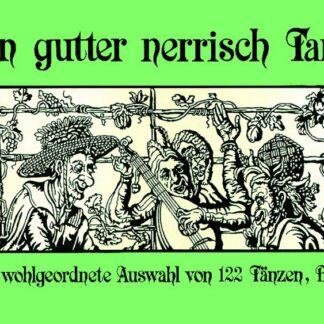Description
By the middle of the 15th century. a wealthy and educated citizen in the Nuremberg area collected a number of songs for private use and arranged for them to be written down in bound form: This collection, later called the Lochamer Liederbuch, is nowadays often referred to somewhat polemically and not entirely accurately as the first German songbook.
In any case, however, it occupies a special position in the tradition of German-language songs with its 41 vocal pieces. Its importance was further increased with the later addition of an instrumental section containing 32 arrangements. The songbook and especially the instrumental collection probably originated in the environment of the famous blind organist and lute player Conrad Paumann, who was also active in Nuremberg.
Although a well-researched scholarly translation of the songbook has been available for some time, the practical performability of the pieces has not been a primary concern in previous editions.
This edition contains a selection of monophonic and polyphonic songs as well as corresponding instrumental arrangements in a new transcription from the original. Although the emphasis is on the playability of the pieces and the edition is supplemented with practical performance notes, it also meets scholarly standards through a critical commentary.
In addition to popular and well-known classics, such as Wach auf mein hort by Oswald von Wolkenstein and the polyphonic Der wallt hat sich entlawbet, lesser-known and no less beautiful melodies also found their way into this compilation, including, for example, Möcht ich dein begeren and Ein vrouleen edel von natüren.
English:
In the middle of the 15th century, a wealthy, well-educated citizen from the Nuremberg area compiled a number of songs for private use, had them written down and bound: This collection, which became known later as the “Locham Songbook”, is nowadays frequently identified – not entirely correctly – as the first German-language songbook.
With its 41 songs, it occupies a special position within the tradition of songs in the German language. The addition of a chapter with instrumental music containing 32 arrangements even enhanced its importance. The origins of the songbook, and in particular the collection of instrumental music, can probably be linked to the famous blind organist and lutenist Conrad Paumann, who was also active in Nuremberg.
A well-researched scientific transcription of the songbook has been available for some time, practical aspects of performance, however, had not been a major concern of previous editions. The present edition contains a selection of mono- and polyphonic songs as well as related instrumental arrangements in a new transcription from the original. Although the focus is on the playability of the pieces and the edition is complemented by notes on performance practice, its commentary fulfils scientific standards.
In addition to well-known, popular ‘classics’ such as ‘Wach auf mein hort’ by Oswald von Wolkenstein and the polyphonic ‘Der wallt hat sich entlawbet’, less known, but no less beautiful tunes were included in this compilation, e.g. ‘Möcht ich dein begeren’ or ‘Ein vrouleen edel von natüren’.
The CD to go with this book: CD ‘Das Lochamer-Liederbuch’, recorded by Ensemble Dulce Melos and Martin Hummel (NAXOS).
Order no:
83-4
ISBN: 978-3-927240-83-4
Edition 2nd, improved edition 2016
Format: DIN A4
Number of pages: 48 pages
Cover: Softcover
Review of the magazine of history chronico (www.chronico.de):
“With the Manessische Liederhandschrift (Codex Manesse), written around 1300 at the latest, the time of the transmission of literature and songs based primarily on oral tradition was over. Some German-language song manuscripts as well as songbooks from the late Middle Ages and the beginning of modern times are known today. The Locham Songbook from around 1460 is one of the most important collections, if only because of its size.
In 2007/8, the musician and musicologist Marc Lewon presented the songbook in two copies: Lewon recorded 26 of the approximately 50 pieces of the Locham songbook with his ensemble Dulce Melos and the baritone Martin Hummel (Naxos). A two-part print edition about the songbook was also published by Verlag der Spielleute.
The point is this: Well-preserved songbooks that also still come up with detailed melodies (even if not with measures or exact pitches, that was not common in the Middle Ages) are a treat first of all for researchers. They do exist, the scientific treatises on the Locham Songbook. The naturally practice-oriented modern musician, however, needs other doors to open to such historical material. Regardless of whether he is concerned with free interpretations or performances that are as authentic as possible. One such door is the two-volume edition by Marc Lewon. Lewon has transferred and prepared a total of 20 monophonic and polyphonic songs for this edition. Musical performability of the pieces is the goal of the exercise. Meticulously Lewon transfers the notes and decided to use a modern beat. The author makes it clear at the outset that this alone makes his work something of an interpretation. Lewon conscientiously prepares text melodies and instrumental parts and is not stingy with detailed comments and hints for playing practice. …
(see http://chronico.de/besprechen/musik/0000511/)






Reviews
There are no reviews yet.